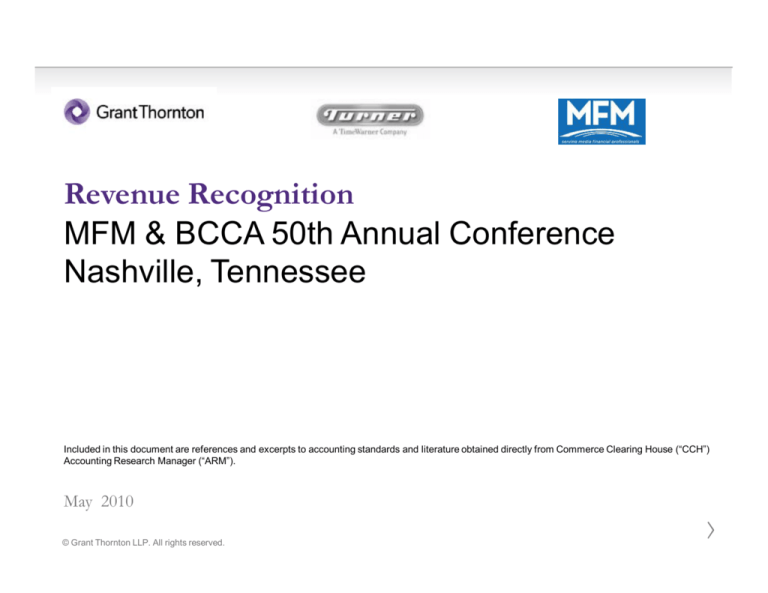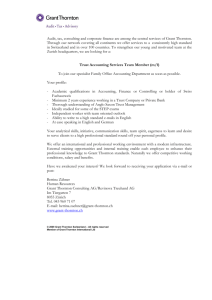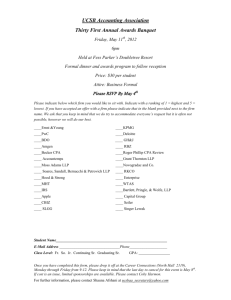
Revenue Recognition
MFM & BCCA 50th Annual Conference
Nashville, Tennessee
Included in this document are references and excerpts to accounting standards and literature obtained directly from Commerce Clearing House (“CCH”)
Accounting Research Manager (“ARM”).
May 2010
© Grant Thornton LLP. All rights reserved.
1
Agenda
General Revenue Recognition
Foundation for Revenue Recognition, SAB 104
Multiple Element Arrangements, ASC 605-25
Principal Agent Considerations, ASC 605-45
Interactive Revenue
Presenters
Appendix
Collaborative Arrangements
Multiple Element Arrangements (MEA) - Other
Revenue Recognition Considerations
Included in this document are references and excerpts to accounting standards and literature obtained directly from Commerce Clearing House (“CCH”) Accounting
Research Manager (“ARM”).
© Grant Thornton LLP. All rights reserved.
2
Revenue Recognition
Overview
•
•
•
Authoritative Literature
SAB 104 Public Company Guidance
Concept Statements
Revenue Recognition Guidance
• Revenue will be recognized when it is earned and realized.
• Revenue is considered earned when the Company has substantially
accomplished what it must do to be entitled to the benefits represented by
the revenue. Generally this happens upon performance or delivery of the
service or product.
• Cash received prior to the performance or delivery of the service or
product is recorded as deferred revenue.
• Revenue is realized when goods or services, merchandise, or other assets
are exchanged for cash or claims to cash.
• As a component of revenue being recognized, it must also be realizable;
that is, when related assets received or held are readily convertible to
known amounts of cash or claims to cash.
© Grant Thornton LLP. All rights reserved.
3
Significant GAAP Guidance
•
•
•
•
•
•
•
•
•
•
•
ASC 920-10
ASC 845-10
ASC 605-20
ASC 605-45
ASC 605-25
ASC 605-50
ASC 808-10
ASC 926-10
SAB 101
SAB 104
CON 5
•
CON 6
Entertainment- Broadcasters
Nonmonetary Transactions
Services
Principal Agent Considerations
Multiple Element Arrangements
Customer Payments and Incentives
Collaborative Arrangements
Entertainment-Films
Revenue Recognition in Financial Statements
Revenue Recognition (Revised SAB 101)
Recognition and Measurement in Financial Statements of Business
Enterprises
Elements of Financial Statements
Note: This listing of technical accounting literature is not meant to be all
inclusive but rather a list of the guidance more frequently cited in accounting
literature. There are numerous other pieces of literature related to revenue
recognition in US GAAP.
© Grant Thornton LLP. All rights reserved.
4
Foundation of Revenue Recognition
Staff Accounting Bulletin 104 (“SAB 104”)
Revenue Recognition
(Revised SAB 101, Revenue Recognition in
Financial Statements)
© Grant Thornton LLP. All rights reserved.
5
SAB 104, Revenue Recognition
Criteria
1. Persuasive evidence of an arrangement exists,
2. Delivery has occurred or services have been rendered,
3. The seller’s price to the buyer is fixed or determinable, and
4. Collectability is reasonably assured
© Grant Thornton LLP. All rights reserved.
6
SAB 104 Revenue Recognition
Persuasive Evidence of an Arrangement
• Identifies the seller’s obligations
• Facilitates analysis of whether the seller has fulfilled those obligations and
earned revenue
• Provides legal basis on which the seller can demand payment
Forms of Evidence
•
•
•
•
•
No specific guidance on persuasive evidence qualifications
Written contract
Sales receipt
Other forms of written or electronic evidence that is expected to be present
Binding written agreement does not have to exist
© Grant Thornton LLP. All rights reserved.
7
SAB 104 Revenue Recognition
Delivery
• Delivery or Performance of Services
• Facilitates assessment of whether the obligation(s) undertaken by the seller
have been completed in part or in whole
• Revenue Recognition Models Based on Delivery
• Completed performance: single point in time when seller performs
obligation and buyer receives benefit (immediate recognition)
• Proportional performance: seller performs and customer receives value
over time (recognition over performance period)
© Grant Thornton LLP. All rights reserved.
8
SAB 104 Revenue Recognition
Delivery
Examples
• Advertising Revenue and Underdelivery
• ABC sells a 30 second ad spot for $100 and promises to deliver 100
eyeballs.
• Actual delivery is 90 eyeballs
• ABC records a receivable for $100, revenue of $90 and an underdelivery reserve of $10 (defer $10 of revenue)
• Subscription for annual membership
• Cash is collected up front from subscriber for an annual membership
• The offset to cash is deferred revenue
• Revenue is recognized ratably over the 12-month term because ABC is
required to provide service over subscription period.
© Grant Thornton LLP. All rights reserved.
9
SAB 104 Revenue Recognition
Delivery
Examples
• Content Syndication
• On February 1, 2008, ABC signs an agreement to license season 1 of
Syndicated Show in syndication to XYZ Network for $4M over a 4
year term.
• On May 1, 2008, the license period begins and ABC makes available to
XYZ all the episodes in season 1.
• The $4M is paid to ABC in 48 equal monthly installments over the
term. Collectability is reasonably assured.
• ABC recognizes $3.6M of revenue on May 1, 2008 which represents
the present value of the payments over the term.
© Grant Thornton LLP. All rights reserved.
10
SAB 104 Revenue Recognition
Fixed Price
Fixed or Determinable Sales Price
• Fee must be fixed or determinable to determine how much revenue is
realizable
• A fixed fee suggests a “meeting of the minds”
Determination of Fixed Price
• No specific definition in the guidance
• Amounts contingent or variable based on future events are not fixed until
those specified events occur
• Must consider cancellation or termination clauses and refund rights
• Not an “all or nothing” determination
© Grant Thornton LLP. All rights reserved.
11
SAB 104 Revenue Recognition
Fixed Price
Examples
• Subscription Revenue
• MSO is contractually obligated to pay ABC $1 per subscriber per
month for Network
• The current month is October 2008
• MSO provides ABC with the actual number of subscribers for August
2008 (10M subs). ABC may make adjustments to this number based
on historical growth trends and industry indicators. These estimates
have a history of being relatively accurate. For the purposes of this
example, assume no adjustments were made.
• ABC recognizes $10M in subscription revenue for Network in October
2008.
• Fixed or determinable criteria met since rate per subscriber is fixed and
number of subscribers is reasonably estimable
© Grant Thornton LLP. All rights reserved.
12
SAB 104 Revenue Recognition
Collectability
Reasonably Assured Collectability
• Assesses whether the revenue is realizable
Determination of Collectability
• No specific criteria in guidance
• Consideration should be given to:
• Payment history
• Credit checks
• Early cancellation provisions
• If collectability is not reasonably assured, revenue should be recognized
upon receipt of cash
© Grant Thornton LLP. All rights reserved.
13
ASC 605-25 Multiple Element Arrangements
© Grant Thornton LLP. All rights reserved.
14
ASC 605-25 Multiple Element Arrangement
• In October 2009, new guidance (formerly known as EITF 08-1) was issued
related to the accounting for multiple-deliverable revenue arrangements.
• This new guidance amends the existing guidance for separating consideration in
multiple-deliverable arrangements and establishes a selling price hierarchy for
determining the selling price of a deliverable.
• This guidance will become effective January 1, 2011 (on a prospective basis).
• Early adoption permitted - beginning January 1, 2010
© Grant Thornton LLP. All rights reserved.
15
ASC 605-25 Multiple Element Arrangement
The new guidance was adopted by the FASB primarily due to the following:
• The absence of objective and reliable evidence of fair value of the undelivered
item in an arrangement is a common reason entities are unable to separate
deliverables in an arrangement under EITF Issue 00-21 and this often
results in accounting that many believe does not reflect the underlying
economics of a transaction.
• This issue was taken on by the EITF to explore whether the objective-andreliable-evidence-of-fair-value threshold in EITF Issue 00-21 should be
modified to allow the use of an estimated selling price for the undelivered unit
of accounting in transactions in which vendor-specific objective evidence
(VSOE) or acceptable third-party evidence (TPE) of the selling price for an
undelivered unit of accounting are unavailable.
© Grant Thornton LLP. All rights reserved.
16
ASC 605-25 Multiple Element Arrangement
• The conclusions reached change the existing multiple element arrangement
model in EITF 00-21 in that:
•
1.
Separation will no longer be predicated on having objective and reliable
evidence of the fair value of the undelivered item;
2.
Allocation of arrangement consideration will be based on selling price
with the evidence of selling price based on a) vendor-specific objective
evidence (“VSOE”), b) third-party evidence (“TPE”) or c) the entity’s
best estimate; and
3.
The residual method of allocating consideration would be eliminated
and replaced with the “relative-selling-price” method.
To address concerns some Task Force members has about Companies estimates
of selling price, enhanced disclosures would be required in this area.
© Grant Thornton LLP. All rights reserved.
17
ASC 605-25 Multiple Element Arrangement
Unit of Accounting
A delivered item or items shall be considered a separate element for accounting
purposes if both of the following conditions are met:
• The delivered item or items have value to the customer on a stand-alone basis.
• If the delivered item(s) is sold separately by any vendor or the customer could
resell the delivered item(s) on a stand-alone basis.
• If the arrangement includes a general right of return related to the delivered
item, delivery or performance of the undelivered item or items is considered
probable and substantially in the control of the vendor.
If the separation conditions are met, the delivered item(s) must be treated separately
for accounting purposes.
An entity does not have the option to bundle elements that otherwise satisfy these
conditions.
© Grant Thornton LLP. All rights reserved.
18
ASC 605-25 Multiple Element Arrangement
Multiple Arrangements
Separate contracts with the same entity or related parties that are entered into at or
near the same time are generally presumed to have been negotiated as a package. This
"package" of arrangements shall be evaluated as a single arrangement for purposes
of applying the model.
© Grant Thornton LLP. All rights reserved.
19
ASC 605-25 Multiple Element Arrangement
Measurement and Allocation of Arrangement Consideration
Consideration shall be allocated at the inception of the arrangement to all
deliverables on the basis of their relative selling price (the relative selling price
method).
When applying the relative selling price method, the selling price for each deliverable
shall be determined using:
• Vendor-specific objective evidence of selling price, if it exists; or otherwise
• Third-party evidence of selling price
• If neither vendor-specific objective evidence nor third-party evidence of selling
price exists for a deliverable, the vendor should use its best estimate of the selling
price for that deliverable when applying the relative selling price method.
.
©Grant Thornton LLP. All rights reserved
20
ASC 605-25 Multiple Element Arrangement
Measurement and Allocation of Arrangement Consideration
Other Considerations
• To the extent that any separate unit of accounting in the arrangement is required
by guidance included in another Topic to be recorded at fair value (and marked to
market each reporting period thereafter), the amount allocated to that unit of
accounting shall be its fair value. Under those circumstances, the remainder of
arrangement consideration shall be allocated to the other units of accounting.
• The amount allocable to the delivered unit or units of accounting is limited to the
amount that is not contingent upon the delivery of additional items or meeting
other specified performance conditions (the noncontingent amount). That is, the
amount allocable to the delivered unit or units of accounting is the lesser of the
© Grant Thornton LLP. All rights reserved.
21
ASC 605-25 Multiple Element Arrangement
Measurement and Allocation of Arrangement Consideration
Other Considerations
• Applicable revenue recognition criteria shall be considered separately for separate
units of accounting.
• The measurement of revenue per period shall be limited to the measurement that
results from assuming that cancellation of the arrangement will not occur.
Grant Thornton LLP. All rights reserved.
22
ASC 605-25 Multiple Element Arrangement
Determining the Selling Price
Vendor-specific objective evidence of selling price is limited to either of the
following:
• The price charged for a deliverable when it is sold separately; or
• For a deliverable not yet being sold separately, the price established by management
having the relevant authority
• It must be probable that the price, once established, will not change before the separate
introduction of the deliverable into the marketplace.
Other considerations:
• Third-party evidence of selling price is the price of the vendor’s or any
competitor's largely interchangeable products or services in standalone sales to
similarly situated customers.
© Grant Thornton LLP. All rights reserved.
23
ASC 605-25 Multiple Element Arrangement
Determining the Selling Price
• The vendor’s best estimate of selling price shall be consistent with the objective of
determining vendor-specific objective evidence of selling price for the deliverable.
• The price at which the vendor would transact if the deliverable were sold by
the vendor regularly on a standalone basis).
• The vendor shall consider market conditions as well as entity-specific factors
when estimating the selling price.
• Contractually stated prices for individual products or services in an arrangement
with multiple deliverables shall not be presumed to be representative of vendorspecific objective evidence, third-party evidence, or a vendor’s best estimate of
selling price.
Grant Thornton LLP. All rights reserved.
24
ASC 605-25 Multiple Element Arrangement
Other Considerations (see Appendix for details on these topics)
Inconsequential or Perfunctory Activities
If an activity performed by the vendor is considered inconsequential or perfunctory,
it may not have to be considered a deliverable for purposes of applying the model.
Contingent Consideration
Contingent consideration includes specific refund rights and performance bonuses.
Performance bonuses are payments due from customers only if specified
performance conditions are met.
Customer Cancellation Provisions
In some cases, an arrangement includes a provision for the customer to cancel or
terminate the arrangement with the payment of a termination fee.
© Grant Thornton LLP. All rights reserved.
25
ASC 605-25 Multiple Element Arrangement
Other Considerations (see Appendix for details on these topics)
Other Subtopic 605-25 Scope Considerations
The following are excluded from the scope of Subtopic 605-25:
• Arrangements involving free or discounted products or services to be delivered at
a future date
• Arrangements related to point and loyalty programs regardless of whether the
vendor is the program operator
• Payments related to research or development deliverables that are accounted for
under the milestone method of revenue recognition
Disclosure requirements
A vendor is expected to disclose the qualitative and quantitative information necessary
to comply with the disclosure objective. The disclosure objective is to provide both
qualitative and quantitative information about: (a) a vendor’s revenue arrangements; (b)
the significant judgments made in the application of Subtopic 605-25; and (c) changes in
those judgments or the application of Subtopic 605-25 that may affect the timing or
amount of revenue recognition
. © Grant Thornton LLP. All rights reserved.
26
ASC 605-25 Multiple Element Arrangements
Measurement and Allocation of Consideration
•
Company XYZ manufactures and sells 3 types of products: Products A, B, &
C
•
Product A’s retail price is $10, Product B’s retail price is $20 and Product C’s
retail price is $30
•
Company XYZ enters into an arrangement to sell Customer #1 Products A, B
& C for a total of $30
•
Use of the relative selling price method of allocating the $30 of revenue from
the transaction with Customer #1 results in the allocation of the following
amounts of revenue to each of the products sold:
– Product A = $5 ($30 x 17%)
– Product B = $10 ($30 x 33%)
– Product C = $15 ($30 x 50%)
© Grant Thornton LLP. All rights reserved.
27
ASC 605-25 Multiple Element Arrangements
Cable Provider Bundle
Cable provider sells video, high-speed data (internet) and voice
services to subscribers. Individually, these services are priced per
month at $60, $40 and $35, respectively. These services are also sold
as a bundle for a price of $110 a month (a savings of $25 per month).
Question
• How much of the $110 consideration is allocated to each
deliverable?
Assumption is that all 3 services are
Answer
• Video: $48.89 [$60 x ($110/$135)]
• Internet: $32.59 [$40 x ($110/$135)]
• Voice: $28.52 [$35 x ($110/$135)]
© Grant Thornton LLP. All rights reserved.
28
delivered at the same time and the
allocation of the 3 separate services
(video, internet and voice) is required in
order to record revenue by these separate
revenue streams.
ASC 605-45 Principal Agent Considerations
© Grant Thornton LLP. All rights reserved.
29
ASC 605-45 Principal Agent Considerations
Gross vs. Net
Should the entire amount received from an end-user be recorded as revenue and the
amount paid to the supplier as cost of sales (gross) or just the net amount as
revenue (net)?
Indicators of Gross
1.
2.
3.
4.
5.
6.
7.
8.
ABC is the primary obligor
ABC has general inventory risk
ABC has the ability to determine the sales price
ABC changes the product or performs part of the service
ABC has discretion in supplier selection
ABC is involved in determining the product or service specifications
ABC has physical loss inventory risk
ABC has credit risk
Indicators of Net
1.
2.
3.
The supplier is the primary obligor in the arrangement
The amount ABC earns per transaction is fixed
The supplier has credit risk
© Grant Thornton LLP. All rights reserved.
30
ASC 605-45 Principal Agent Considerations
Example
ABC enters into an agreement with Acme Sports. Acme Sports owns the rights to
the Acme Sports websites. Under the agreement ABC will sell, bill and collect
advertising revenue generated from the websites. In exchange for its services, ABC
will be compensated by retaining 60% of the ad revenue. The other 40% is remitted
to Acme Sports. During the first year of the agreement, ABC sells $100 of ad
revenue.
Question:
How should ABC recognize revenue in this transaction?
a) $100 as revenue and $40 as cost of revenue
b) $60 as net revenue
© Grant Thornton LLP. All rights reserved.
31
ASC 605-45 Principal Agent Considerations
ACME Sports Example
Yes No NA
Indicators of gross reporting
1 ABC is primary obligor
2 ABC has general inventory risk
3 ABC can determine price
4 ABC performs part of the service
5 ABC has discretion in supplier selection
6 ABC is involved in determining service specifications
7 ABC has physical loss of inventory
8 ABC has credit risk
Indicators of net reporting
1 Third-party is the primary obligor
2 The amount earned by ABC is fixed
3 Third-party has credit risk
© Grant Thornton LLP. All rights reserved.
32
X
X
X
X
X
X
X
X
X
X
X
ASC 605-45 Principal Agent Considerations
Example
ABC enters into an agreement with Acme Sports. Acme Sports owns the rights to
the Acme Sports websites. Under the agreement ABC will sell, bill and collect
advertising revenue generated from the websites. In exchange for its services, ABC
will be compensated by retaining 60% of the ad revenue. The other 40% is remitted
to Acme Sports. During the first year of the agreement, ABC sells $100 of ad
revenue.
Question:
How should ABC recognize revenue in this transaction?
a) $100 as revenue and $40 as cost of revenue
© Grant Thornton LLP. All rights reserved.
33
Interactive Revenue
© Grant Thornton LLP. All rights reserved.
34
ASC 605-20 Services
Interactive Revenue
• The same general principles discussed above are applicable for revenues
generated by online advertising revenue and online subscription revenue
• Online revenue can be generated from standalone agreements or can be
part of an overall “bundled” agreement containing multiple deliverables
and therefore a company may need to consider the guidance of ASC 60525 Multiple Element Arrangements
• Some of the most common revenue considerations resulting from online
advertising revenue include: revenue based on performance (i.e., pageviews,
clickthroughs, etc.), minimum guarantee interplay with performance based
arrangements, and revenue share arrangements
© Grant Thornton LLP. All rights reserved.
35
Interactive Rev – Minimum Guarantee
Example
Background
• ABC has many arrangements whereby they partner with third parties to
monetize ABC’s content. One such example is when ABC provides the
content and a third party may sell the advertising around the content.
• ABC may be compensated by the third party in the following ways:
a. With a fixed fee
b. A share of the advertising revenue that the third party generates
c. Both a and b.
• The third party may also guarantee a certain dollar amount of advertising
revenue share ABC will receive over the term.
© Grant Thornton LLP. All rights reserved.
36
Interactive Rev – Minimum Guarantee
Example
•
ABC has a one year agreement with Radio Station B whereby ABC provides a
live feed of Network C for broadcast on Radio Station B’s satellite radio
network.
•
The commercials that appear on the television network of Network C are not
replicated on Radio Station B. Rather, Radio Station B sells advertising to fill
those spaces between the Network C content. Radio Station B agrees to share
this ad revenue 50/50 with ABC. Additionally, Radio Station B guarantees that
ABC will receive at least $120,000 annually in ad revenue share.
•
ABC’s only obligation is to provide the signal for the Network C to Radio
Station B. ABC makes no guarantee on audience delivery.
© Grant Thornton LLP. All rights reserved.
37
Interactive Rev – Minimum Guarantee
Example
Questions
1.
How should revenue be recognized under this arrangement? Why?
a) Straight-line of the minimum guarantee ($10,000 a month) with a true up
at the end for any excess earned over $120,000.
b) Recognize actual ad revenue share earned each month.
c) Other
2.
What is the basis for your answer?
3.
How should Radio Station B recognize revenue share expense under this
agreement?
© Grant Thornton LLP. All rights reserved.
38
Interactive Rev – Minimum Guarantee
Example Continued
The table below illustrates how the revenue share was earned over the 12-month
term and how revenue should be recognized.
Revenue Recognized
Revenue
Share
Earned
January
$
15,000
February
15,000
March
15,000
April
May
June
July
25,000
August
30,000
September
20,000
October
November
40,000
December
30,000
$ 190,000
© Grant Thornton LLP. All rights reserved.
Cumulative
Revenue
Share
Earned
15,000
30,000
45,000
45,000
45,000
45,000
70,000
100,000
120,000
120,000
160,000
190,000
SL of the
MG
$ 10,000
10,000
10,000
10,000
10,000
10,000
10,000
10,000
10,000
10,000
10,000
10,000
$ 120,000
39
Actual
Performance in
Excess of MG
Total
Cumulative
$
$ 10,000 $
10,000
10,000
20,000
10,000
30,000
10,000
40,000
10,000
50,000
10,000
60,000
10,000
70,000
10,000
80,000
10,000
90,000
10,000
100,000
40,000
50,000
150,000
30,000
40,000
190,000
$
70,000 $ 190,000
Interactive Rev – Minimum Guarantee
Minimum Guarantee Example
Company XYZ agrees to pay ABC $1 per impression delivered from ABC.com
over a one year term. XYZ commits to pay ABC a minimum guarantee of
$12,000. Additionally, the parties agree that ABC will target a delivery of 12,000
impressions; however, there are no penalties for not delivering 12,000 impressions.
The table on the following page illustrates how the impressions were delivered
over the 12-month term and how revenue should be recognized.
© Grant Thornton LLP. All rights reserved.
40
Interactive Rev – Minimum Guarantee
Minimum Guarantee Example Continued
Revenue Recognized
Impressions
Delivered
January
February
March
Cumulative
Impressions
Delivered
500
500
1,000
1,500
1,000
Actual
SL of the MG Performance in Total
Excess of MG
Cumulative
$
$
1,000
$
-
$ 1,000
1,000
1,000
-
1,000
2,000
2,500
1,000
-
1,000
3,000
April
2,000
4,500
1,000
-
1,000
4,000
May
-
4,500
1,000
-
1,000
5,000
June
500
5,000
1,000
-
1,000
6,000
July
2,000
7,000
1,000
-
1,000
7,000
August
3,000
10,000
1,000
-
1,000
8,000
September
2,000
12,000
1,000
-
1,000
9,000
-
12,000
1,000
-
1,000
10,000
November
4,000
16,000
1,000
4,000
5,000
15,000
December
3,000
19,000
1,000
3,000
4,000
19,000
7,000
$ 19,000
October
19,000
© Grant Thornton LLP. All rights reserved.
$
12,000
41
$
ASC 605-20 Services
Interactive Rev –Performance-Based Revenue
• Certain arrangements involving online advertising revenue call for
performance by the online business (i.e., website) in exchange for
consideration paid by the online advertiser
• The performance by the online business can include the online business
agreeing to provide an agreed upon number of pageviews, clickthroughs or
unique users over the term of the agreement
• In situations where the online business is providing advertising services over
the term, it is appropriate to recognize the revenue as the online business is
delivering the advertising
Example
Company XYZ agrees to pay Company ABC $1 per unique user delivered from
ABC.com over a one-year term. Assume during the first month of the term,
ABC delivers 300 unique users.
Revenue Recognition
In this scenario, it is appropriate for Company ABC to recognize $300 of revenue
for the first month.
© Grant Thornton LLP. All rights reserved.
42
Wrap Up
© Grant Thornton LLP. All rights reserved.
43
Appendices
• Collaborative Arrangements
• Multiple Element Arrangements (MEA) – Other
Revenue Recognition Considerations
© Grant Thornton LLP. All rights reserved.
44
ASC 808-10 Accounting for Collaborative
Arrangements
© Grant Thornton LLP. All rights reserved.
45
ASC 808-10 Accounting for Collaborative
Arrangements
•
•
•
A contractual arrangement that includes a joint operating activity
Involves two ( or more) parties who are both (a) active participants in the
activity and (b) exposed to significant risks and rewards dependent on the
commercial success of the activity
Provides guidance for income statement presentation, classification, and
disclosure
ASC 808-10 does not address recognition or measurement matters related to
collaborative arrangements, for example, determining the appropriate units of
accounting, the appropriate recognition requirement for a given unit of
accounting, or when the recognition criteria are met.
© Grant Thornton LLP. All rights reserved.
46
ASC 808-10 Accounting for Collaborative
Arrangements
Key Terms
•
Joint Operating Activity
– The joint operating activities of a collaborative arrangement might involve joint
development and commercialization of intellectual property, a drug candidate, software,
computer hardware, or a motion picture.
• Active Participation
–
Whether the parties in a collaborative arrangement are active participants will depend on
the facts and circumstances specific to the arrangement. Examples of situations that may
evidence active participation of the parties in a collaborative arrangement include, but are
not limited to, the following:
– Directing and carrying out the activities of the joint operating activity
– Participating on a steering committee or other oversight or governance mechanism
– Holding a contractual or other legal right to the underlying intellectual property.
© Grant Thornton LLP. All rights reserved.
47
ASC 808-10 Accounting for Collaborative
Arrangements
Key Terms
• Significant risks and rewards
– Whether the participants in a collaborative arrangement are exposed to significant
risks and rewards dependent on the commercial success of the joint operating
activity depends on the facts and circumstances specific to the arrangement,
including, but not limited to, the terms and conditions of the arrangement.
– The terms and conditions of the arrangement might indicate that participants are
not exposed to significant risks and rewards if, for example:
– Services are performed in exchange for fees paid at market rates.
– A participant is able to exit the arrangement without cause and recover all ( or
a significant portion) of its cumulative economic participation to date.
– Initial profits are allocated to only one participant
– There is a limit on the reward that accrues to a participant.
© Grant Thornton LLP. All rights reserved.
48
ASC 808-10 Accounting for Collaborative
Arrangements
Key Terms
• Other Presentation Matters ( Income Statement Classification)
– Participants in a collaborative arrangement shall report costs incurred and revenue
generated from transactions with third parties ( that is parties that do not participate
in the arrangement) in each entity’s respective income statement pursuant to the
guidance in Subtopic 605-45 Principal Agent Considerations. An entity should not
apply the equity method of accounting under Subtopic 323-10 (InvestmentsEquity Method) and Joint Ventures and 323-30 ( Joint Ventures and Limited
Liability Entities) to activities of collaborative arrangements.
– Payments between participants pursuant to a collaborative arrangement that are
within the scope of other authoritative accounting literature on income statement
classification should be accounted for using the relevant provisions of that
literature. If the payments are not within the scope of other authoritative
accounting literature, the income statement classification for the payments should
be based on an analogy to authoritative accounting literature or if there is no
appropriate analogy, a reasonable, rational, and consistently applied accounting
policy election.
© Grant Thornton LLP. All rights reserved.
49
Multiple Element Arrangements (MEA) - Other
Revenue Recognition Considerations
© Grant Thornton LLP. All rights reserved.
50
MEA - Other Revenue Recognition
Considerations
Inconsequential or Perfunctory Activities
If an activity performed by the vendor is considered inconsequential or perfunctory, it
may not have to be considered a deliverable for purposes of applying the model. Care
shall be exercised in this regard as activities that are part of a revenue-generating
multiple-element arrangement are presumed to be more than inconsequential or
perfunctory.
See the SEC Registrants discussion below related to factors that shall be considered in
assessing whether an item is inconsequential or perfunctory. If an activity is considered
inconsequential or perfunctory, the costs of performing the activity are accrued at the
time that revenue is recognized related to other elements in the multiple-element
arrangement. Activities that may be considered inconsequential or perfunctory shall be
analyzed in the aggregate. This SEC guidance is not mandatory for private companies,
although they should still consider its application given the absence of other guidance.
© Grant Thornton LLP. All rights reserved.
51
MEA - Other Revenue Recognition
Considerations
Contingent Consideration
Contingent consideration includes specific refund rights and performance bonuses.
Specific refund rights provide a customer with a refund or concession related to a
delivered element only if the vendor fails to provide any undelivered elements in
the arrangement. When specific refund rights exist, the amount of arrangement
consideration allocated to a delivered element is limited to the lesser of: (a) the fair
value of that element; or (b) the amount that is not contingent upon the delivery
of additional elements or meeting other specified performance conditions.
Performance bonuses are payments due from customers only if specified
performance conditions are met. Performance bonuses shall not be considered in
the allocation of arrangement consideration until the performance criteria have
been met.
© Grant Thornton LLP. All rights reserved.
52
MEA - Other Revenue Recognition
Considerations
Customer Cancellation Provisions
In some cases, an arrangement includes a provision for the customer to cancel or
terminate the arrangement with the payment of a termination fee. When this type
of provision exists, the vendor shall assume that the customer will not cancel.
However, situations may arise where an asset is recorded for the excess of revenue
recognized under the arrangement over the amount of cash received
© Grant Thornton LLP. All rights reserved.
53
MEA - Other Revenue Recognition
Considerations
Customer Cancellation Provisions
from the customer since the inception of the arrangement. In those situations, for
purposes of supporting recognition of the asset: (a) the asset shall not exceed the
cancellation fee to which the vendor is entitled under the arrangement; (b) the
vendor's right to the cancellation fee must be legally enforceable; and (c) the vendor
shall have the intent to enforce its contractual right to collect the cancellation fee.
Other Subtopic 605-25 Scope Considerations
The following are excluded from the scope of Subtopic 605-25:
• Arrangements involving free or discounted products or services to be delivered
at a future date, or a rebate or refund of a determinable cash amount, if the
customer reaches a predefined threshold of cumulative revenue transactions with
the vendor or continues to be a customer of the vendor for a predefined period
of time (see the “50 Customer Payments and Incentives - Sales Incentives ”
section of this chapter).
© Grant Thornton LLP. All rights reserved.
54
MEA - Other Revenue Recognition
Considerations
• Arrangements related to point and loyalty programs regardless of whether the
vendor is the program operator (see the “50 Customer Payments and Incentives
- Sales Incentives” section of this chapter).
• Payments related to research or development deliverables that are accounted for
under the milestone method of revenue recognition (see the “28 Milestone
Method ” section of this chapter).
Disclosure
In addition to the items below, a vendor is expected to disclose the qualitative and
quantitative information necessary to comply with the disclosure objective. The
disclosure objective is to provide both qualitative and quantitative information about:
(a) a vendor’s revenue arrangements; (b) the significant judgments made in the
application of Subtopic 605-25 ; and (c) changes in those judgments or the
application of Subtopic 605-25 that may affect the timing or amount of revenue
recognition.
© Grant Thornton LLP. All rights reserved.
55
MEA - Other Revenue Recognition
Considerations
A vendor shall disclose all of the following information by similar type of arrangement:
• The nature of its multiple-deliverable arrangements;
• The significant deliverables within the arrangements;
• The general timing of delivery or performance of service for the deliverables
within the arrangements;
• Performance-, cancellation-, termination-, and refund-type provisions;
• A discussion of the significant factors, inputs, assumptions, and methods used to
determine selling price (whether vendor-specific objective evidence, third-party
evidence, or estimated selling price) for the significant deliverables;
• Whether the significant deliverables in the arrangements qualify as separate units
of accounting, and the reasons that they do not qualify as separate units of
accounting, if applicable;
• The general timing of revenue recognition for significant units of accounting; and
• Separately, the effect of changes in either the selling price or the method or
assumptions used to determine selling price for a specific unit of accounting if
either one of those changes has a significant effect on the allocation of
arrangement consideration.
© Grant Thornton LLP. All rights reserved.
56
MEA - Other Revenue Recognition
Considerations
SEC Registrants
In SAB Topic 13A3c , the SEC staff indicates that if the only remaining performance
obligation on the part of the vendor is inconsequential or perfunctory, the vendor can
still conclude that it has met the delivery or performance criterion necessary to
recognize revenue for the delivered elements.
Inconsequential or Perfunctory Deliverables
While the seller shall assess each element in a multiple element transaction to determine
if it shall be accounted for separately, the seller may adopt a policy of excluding an
inconsequential or perfunctory element from the arrangement's revenue accounting and
accruing the cost of providing the element (see the "15 Products - Recognition —
Uncertainties – Warranties)
© Grant Thornton LLP. All rights reserved.
57
MEA - Other Revenue Recognition
Considerations
and Other Obligations " section of this chapter). In order for an element to be
considered inconsequential or perfunctory it must have both of the following
characteristics:
• The element being evaluated for inconsequential or perfunctory treatment is not
essential to the functionality of other elements in the arrangement that have been
or will be delivered before the element being evaluated; and
• Failure to deliver the element being evaluated for inconsequential or perfunctory
treatment would not result in the customer receiving a full or partial refund or |
rejecting (or a right to a refund or to reject) the elements provided to date.
© Grant Thornton LLP. All rights reserved.
58
MEA - Other Revenue Recognition
Considerations
In addition, the following factors shall also be considered in determining whether an
element is inconsequential or perfunctory:
• Whether the seller has a demonstrated history of completing the remaining tasks
in a timely manner and reliably estimating their costs.
• Whether the cost or time to perform the remaining obligations for similar
contracts historically has varied significantly from one instance to another.
• Whether the skills or equipment required to complete the remaining activity are
specialized or are not readily available in the marketplace.
• Whether the cost of completing the obligation, or the fair value of that
obligation, is more than insignificant in relation to such items as the contract fee,
gross profit, and operating income.
• Whether the period before the remaining obligation will be extinguished is
lengthy (entities shall consider whether reasonably possible variations in the
period to complete performance affect the certainty that the remaining
obligations will be completed successfully and on budget).
• Whether timing of payment of a portion of the sales price is coincident with
completing performance of the remaining activity.
© Grant Thornton LLP. All rights reserved.
59
Presenters
Name
Role
E-mail
Phone
Dwight Delapenha
Audit Partner, Grant
Thornton LLP
Dwight.Delapenha@gt.com
212.542.9524
Brent Smith
Senior Director
Accounting Policy and
Research, Turner
Brent.Smith@turner.com
404.827.1195
© Grant Thornton LLP. All rights reserved.
60
© Grant Thornton LLP
All rights reserved
U.S. member firm of Grant Thornton International Ltd
This proposal is the work of Grant Thornton LLP, the U.S. member firm of Grant Thornton International Ltd, and is in all respects
subject to negotiation, agreement and signing of specific contracts. The information contained within this document is intended only
for the entity or person to which it is addressed and contains confidential and/or proprietary material. Dissemination to third-parties,
copying or use of this information is strictly prohibited without the prior written consent of Grant Thornton LLP.
© Grant Thornton LLP. All rights reserved.
61







